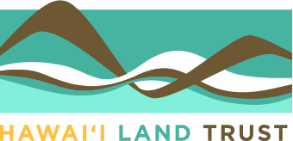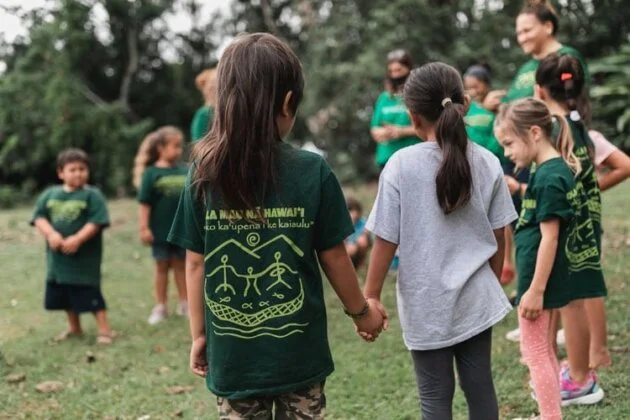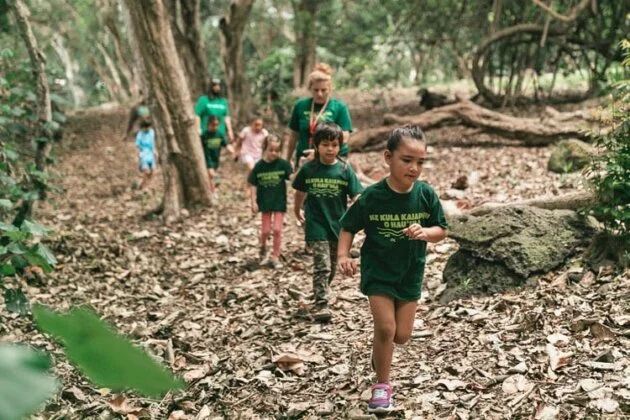KA WAI OLA - Teaching the Next Generation of Land Stewards
A partnership between Hawaiʻi Land Trust and Hauʻula Elementary School is helping to connect keiki to the ʻāina
In rural Oʻahu’s quiet coastal community of Hauʻula is the little-known wahi pana (storied place) of Maunawila.
On Wednesday mornings, the peaceful country road that leads to Maunawila is alive with the excited chatter of keiki walking from nearby Hauʻula Elementary School to attend class at what has become a unique outdoor extension of their school, thanks to a collaboration between Hawaiian nonprofit Hawaiʻi Land Trust (HILT) and Hauʻula Elementary School Principal Uʻilani Kaitoku.
Known formally as the Maunawila Heiau Complex, the 9-acre land parcel, purchased by HILT in 2014, is a short walk from Hauʻula Elementary School. Over the years, as the relationship between HILT and Hauʻula Elementary evolved, Maunawila was gradually incorporated into the school’s curriculum and utilized as an outdoor classroom. This relationship was formalized in 2021 with a Memorandum of Understanding (MOU) agreement – which was fast-tracked to some extent by the onset of the pandemic.
“Kids are already disconnected from the ʻāina because of technology but COVID-19 exacerbated the problem,” said HILT CEO Laura Kaakua. “There were no field trips. Students were isolated at home learning on computer screens.
“Given the growing emphasis on and adoption of ʻāina-based education in schools across the pae ʻāina, in 2020 we pivoted and revised our strategic plan to focus our work on reconnecting people to ʻāina.”
Maunawila is one of seven land preserves that HILT stewards across the pae ʻāina. There are also three on Maui, two on Kauaʻi and one on Hawaiʻi Island. Altogether, HILT has protected nearly 22,000 acres from development. After revising their strategic plan, HILT reached out to area schools proposing the idea of creating MOUs to cut through the paperwork for teachers and school administrators who want to access the land on a regular basis to meet curriculum objectives. Kaitoku was the first school principal to seize the opportunity.
Formalizing the partnership with an MOU has allowed Hauʻula Elementary School kumu and haumāna the flexibility to access the property as needed without all the red tape. “We really appreciate this partnership. It’s been a wonderful experience for the keiki and for our whole school,” said Kaitoku. “And as we help to renew and establish Maunawila, we’re finding that there’s a component of revitalization and renewal within each of us. We come here to work not realizing that we’re actually working on ourselves; as we give back, we’re also benefitting.”
The benefits to the school and its students are evident to Kaitoku and her staff. They have seen students who struggle in the traditional classroom setting blossom and become leaders among their peers at Maunawila. Moreover, the experience of the haumāna working together on the land has helped to change the overall school climate. Kaitoku notes that school attendance is great – especially on “Maunawila days.”
“Students may not do well in school in certain subject areas, but at Maunawila they’re masters, they’re inventors, they’re creative,” said Kaitoku. “Being there allows them to explore more of who they are as a learner. They are learning ʻike in areas like science, history, language, culture – and their reverence to it all is fascinating.
“And when we go back to school it translates. You can see the kids becoming more aware of helping others. They are seeing each other differently like, ‘hey everyone is not like me, but when we’re working together, we can accomplish great things.’ The culture of the school has shifted.”
The larger community is also benefiting. There are community workdays and Maunawila is open to the public 24/7. And HILT also offers summer internship programs for high school students and young adults to teach wahi kūpuna stewardship practices.
“Before, this site was overgrown and kind of thought of as a spooky place,” Kaakua laughed. “Now this whole area is full of kids and interns and their families. The students are really proud to show their ʻohana all the sites around the property and tell the stories about this place. It’s establishing their identity and pride in being from Hauʻula.”
HILT’s new strategic plan has also resulted in some internal changes.
“We protect and steward lands – and teach the next generation to do the same – but we can’t do that unless we’re working directly with teachers in the classrooms and the schools,” said Kaakua. “So we now have more educators on staff than anything – and they are working directly with kumu at the school to plan curriculum and provide instruction.”
Engaging educators from within the community is important to the success of the program. HILT staff at Maunawila include Mamo Leota, Mahealani Keo, Ewaliko Leota and Olivia Wallace, all of whom are from Hauʻula. Their pilina (relationship) to the keiki and the ʻāina is an invaluable asset.
“Iʻm born and raised here in this community and I see the struggles of the families who are from here, so for me it’s important to give these kids a reason to love home and to have a space to come to just regenerate their kino (bodies) so they can face everyday challenges – it’s someplace safe to find healing and learn culture and give service to the community that they are a part of,” said Mamo Leota.
Keo has been with HILT for five years and reflects on the progress that has been made in that short space of time. “The community involvement has been a blessing. Reopening this place, teaching the different moʻolelo, and connecting our people here in this community to this beautiful, healing space. People come here and always leave feeling more at peace.”
In this new school year, Kaakua is hoping HILT will be able to formalize partnerships with at least two other elementary schools – one on Maui and one on Kauaʻi. “We have these longstanding relationships, but if we can just cut down on the paperwork we can make it easier for the schools to bring their students to the ʻāina. That’s our goal. This is not our land. This is the community’s land.” Having access to a protected wahi pana rich with culture and history has transformed learning for keiki in Hauʻula.
“Working at Maunawila has given the kids the tools to ask questions about the land and about themselves – and who they are as learners, caretakers and stewards,” said Kaitoku. “We want students to be able to develop these skill sets because every member of our community needs to understand their kuleana.
“And it goes further than that. We want these keiki to realize their potential and the impact that they can make on the world.”
Hawaiʻi Land Trust is a nonprofit that currently stewards 21,892 acres of land on five islands. Their strategy is to purchase land to protect it from development, to preserve Hawaiian cultural landscapes, and to provide places to grow food through traditional, sustainable farming. The three pillars of their work are: protect, steward and connect. Their work includes ecosystem restoration (removing invasive species, planting native species), historic site restoration, and creating opportunities for the community to interact with the ʻāina. For more information go to: www.hilt.org.





